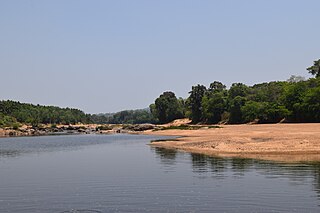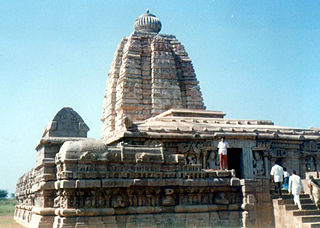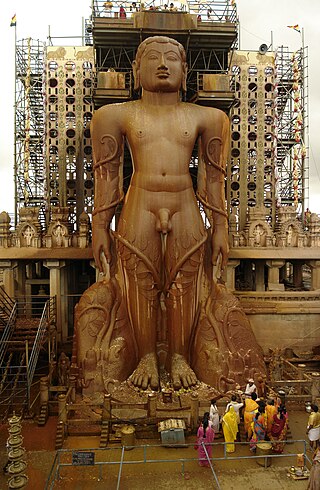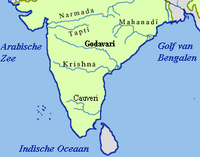
The Krishna River is a river in the Deccan plateau and is the third-longest river in India, after the Ganges and Godavari. It is also the fourth-largest in terms of water inflows and river basin area in India, after the Ganges, Indus and Godavari. The river, also called Krishnaveni, is 1,400 kilometres (870 mi) long and its length in Maharashtra is 282 kilometres. It is a major source of irrigation in the Indian states of Maharashtra, Karnataka, Telangana and Andhra Pradesh.

Koodli, also spelled Kudli or Kudali, is a small historic village in Shimoga District, in the Indian state of Karnataka. It is at the sangam (confluence) of two rivers, the Tunga River and Bhadra River at nearly 1,200 metres (3,937 ft). They meet here to give rise to the Tungabhadra River, a tributary of the Krishna river. Their valleys host many architectural sites. The village was a much larger town and pilgrimage center before the 14th-century, one destroyed during the Islamic conquests of the south. Important temples and their ruins here include the Jagadguru Sri Shankaracharya Dakshinamnaya Sringeri Sharada Peetham, Sangamesvara temple, Ramesvara temple, Sri Chintamani Narasimha temple, Sringeri Vediki temple, Vishwakarma temple, Sharadamba temple, Amma Devasthana, and the Brahmeswara temple. Other scattered ruins of unknown temples are also found here.

The Tunga River is a river in Karnataka state, southern India. The river is born in the Western Ghats on a hill known as Varaha Parvata at a place called Gangamoola. From here, the river flows through two districts in Karnataka - Chikmagalur District and Shimoga District. It is 147 km long and merges with the Bhadra River at Koodli, a small town near Shimoga City, Karnataka. The river is given the compound name Tungabhadra from this point on. The Tungabhadra flows eastwards and merges with the Krishna River in Andhra Pradesh.

Raichur District is an administrative district in the Indian state of Karnataka. It is located in the northeast part of the state and is bounded by Yadgir district in the north, Bijapur and Bagalkot district in the northwest, Koppal district in the west, Bellary district in the south, Jogulamba Gadwal district of Telangana and Kurnool district of Andhra Pradesh in the east.

The Vedavathi is a river in India. It rises from the Bababudanagiri Mountains of Western Ghats and flows through the states of Karnataka and Andhra Pradesh. The Vedavathi is also called the Hagari in Bellary District of Karnataka and parts of Andhra Pradesh. Two rivers, the Veda and Avathi, arise in the eastern part of the Sahyadri Hill range in Bababudangiri mountain ranges, flow east, and join near Pura to form the Vedavathi River. From there the river flows through Kadur Taluk Of Chikkamagalur District. Then it enters Hosadurga Taluk, Hiriyur Taluk and Challakere Taluk of Chitradurga district, respectively.

Hospet is the largest and fastest-growing industrial city and district headquarters of the Vijayanagara district in the Indian state of Karnataka. Hospet is known as "the steel city of Karnataka". It is located on the bank of the Tungabhadra River and is 13 km (8.1 mi) from Hampi (Vijayanagar). Hampi was once the capital of the Vijayanagara Empire. It has been designated a UNESCO World Heritage Site. Hospet is the connecting link between North and South Karnataka. It is 333 km (207 mi) from the state capital Bengaluru.

Kurnool district is one of the eight districts in the Rayalaseema region of the Indian state of Andhra Pradesh after the districts are reorganised in April 2022. It is located in the north western part of the state and is bounded by Nandyal district in the east, Anantapur district in the south, Raichur district of Karnataka in the northwest, Bellary district of Karnataka in the west, and Jogulamba Gadwal district of Telangana in the north. It has a population of 2,271,686 based on the 2011 census. The city of Kurnool is the headquarters of the district.

North Karnataka is a geographical region in Deccan plateau from 300 to 730 metres elevation that constitutes the region of the Karnataka state in India and the region consists of 14 districts. It is drained by the Krishna River and its tributaries the Bhima, Ghataprabha, Malaprabha, and Tungabhadra. North Karnataka lies within the Deccan thorn scrub forests ecoregion, which extends north into eastern Maharashtra.

Alampuram (Hemalapuram) is a town situated in Jogulamba Gadwal district in the Indian state of Telangana. Alampur is a popular Hindu pilgrimage site in Shaktism and is also home to the Navabrahma Temples, a group of nine temples dedicated to Shiva built in the seventh and eighth century CE. It is the meeting point of the rivers Tungabhadra and Krishna and is referred to as Dakshina Kasi and is also considered the western gateway to Srisailam. The sacredness of Alampur is mentioned in the Skanda Purana. It is surrounded by the Nallamala hills and is situated on the left bank of the Tungabhadra River. Alampur was ruled by badami chalukyas they built 9 cluster of shiva temples. After them rashtrakutas of manyakheta and western chalukyas of karnataka built papanasi temples. Alampur is home to multiple Telugu and old Kannada inscriptions .Alampur contains numerous Hindu temples, the prominent ones being Jogulamba temple, Navabrahma temples, Papanasi temples, and Sangameswara Temple.
Siruguppa is a town and headquarters of the Siruguppa taluk and second largest city in Ballari district after Hospete carved out of Ballari district of Indian state of Karnataka.

Ballari, formerly Bellary, is a major district in Karnataka. It is located at north-eastern part of Karnataka. This district belongs to Kalyana-Karnataka. This district was one of the biggest districts in Karnataka until the Vijayanagara district was carved out of Ballari district in 2021 officially.

Karnataka, the sixth largest state in India, has been ranked as the third most popular state in the country for tourism in 2014. It is home to 507 of the 3600 centrally protected monuments in India, second only to Uttar Pradesh. The State Directorate of Archaeology and Museums protects an additional 752 monuments and another 25,000 monuments are yet to receive protection.
Gangamoola is a hill in the Chikkamagaluru district of the state of Karnataka, India. Also known as Varaha Parvata, it is one of the hills in the Western Ghats range and is known for being the source of three rivers, Tunga, Bhadra and Netravathi.

The Bhadra Dam or Lakkavalli Dam, which has created the Bhadra Reservoir, is located on the Bhadra River a tributary of Tungabhadra River. Bhadra Dam is located in the border of Bhadravathi and Tarikere, in the western part of Karnataka in India. The benefits derived from the reservoir storage are irrigation with gross irrigation potential of 162,818 hectares, hydro power generation of 39.2 MW, drinking water supply and industrial use. The dam commissioned in 1965 is a composite earth cum masonry structure of 59.13 metres (194.0 ft) height with length of 1,708 metres (5,604 ft) at the crest level, which submerges a land area of 11,250.88 hectares.
"Rajaolibanda Diversion Scheme" or "RDS" is an irrigation project located across River Tungabhadra in Jogulamba Gadwal district of Telangana, Kurnool district of Andhra pradesh and Raichur district of Karnataka. It is an inter-state barrage on the Tungabhadra river to supply water to Karnataka, Telangana and Andhra Pradesh states. The full reservoir level of this project is 332.32 m MSL.

The Tungabhadra Dam, also known as Pampa Sagar, is a water reservoir constructed across the Tungabhadra River in the city of Hosapete in Vijayanagara district, Karnataka, India. It is a multipurpose dam serving irrigation, electricity generation, flood control, etc. for the state. It is one of the only two non-cement dams in India, the other being the Mullaperiyar Dam in Kerala. The dam is built of surki mortar, a combination of mud and limestone, commonly used at the time of its construction.

The following outline is provided as an overview of and topical guide to Karnataka:

Tungabhadra Pushkaram is a festival of River Tungabhadra normally occurs once in 12 years. This Pushkaram is observed for a period of 12 days from the time of entry of Jupiter into Makara rasi (Capricorn).

Hampi or Vijayanagara is a town in the Vijayanagara district in the Indian state of Karnataka. Located along the Tungabhadra River in the east and center part of the state, Hampi is near the city of Hosapete. It is famous for hosting the Hampi Group of Monuments, a UNESCO World Heritage Site.

Vijayanagara district is a district in the southern Indian state of Karnataka, located in the Kalyana-Karnataka region.



























